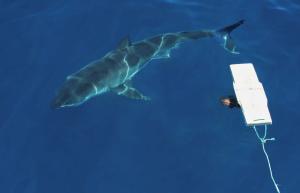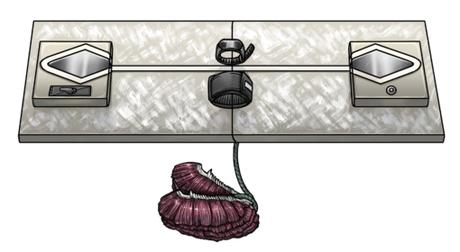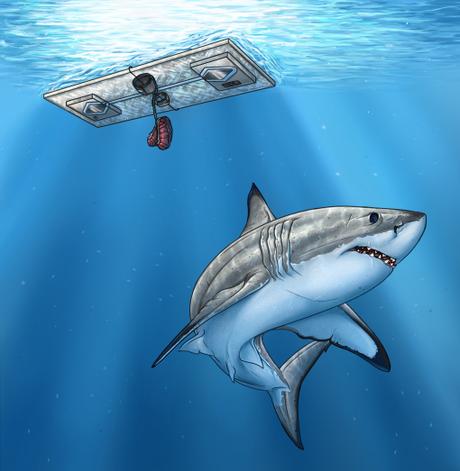
Photo: Charlie Huveneers
A little over a week ago, shark ecologist, Charlie Huveneers, and I attempted to write an article in The Conversation about a report we co-wrote regarding the effectiveness of personal shark-deterrent devices (see below for more on the report itself). It’s a great little story, with both immediate policy implications for human safety and great, big potential improvements to shark conservation in general (i.e., if sharks kill fewer people, then perhaps governments would be less inclined to invokes stupid laws to kill sharks). Indeed, sharks aren’t doing very well around the world, mainly because of over-harvest and persecution from unfounded fear.
Anyway, all was going swimmingly until our editor at The Conversation suddenly decided that they wouldn’t publish the piece based on the following funding disclaimer that we had submitted with the article:
This project was funded by the New South Wales Department of Primary Industries Shark Management Strategy Competitive Annual Grants Program, the Government of South Australia, Ocean Guardian Pty Ltd, and the Neiser Foundation. We openly and transparently declare that Ocean Guardian contributed financially to the study, but that Ocean Guardian was not involved in the study design or implementation, nor did they have access to the data post-collection. Nor did Ocean Guardian provide input into data analysis, interpretation, writing of the report, or the conclusions drawn. The study design followed a protocol developed for a previous study, which was not funded by Ocean Guardian. In summary, Ocean Guardian had no opportunity to influence any aspect of the study or its conclusions, apart from providing some financial support to realize the field project (e.g., boat hire, equipment purchase, etc.) in the same manner as the other funding agencies. The South Australian cage-diving industry provided logistical support during the testing of the deterrents.
The long and short of The Conversation‘s negative decision was that one of the companies contributed financially to project. However, as we stated above, they had absolutely no influence in the subsequent experimental design, data collection, analysis, interpretation or report writing.
While normally I’m a big fan of The Conversation, I really think they dropped the ball with this one. Their decision was illogical and unsupported for five main reasons:
- There were many funding partners involved, and the Ocean Freedom contribution was in no way the major or even majority share of funding.
- Other companies with devices tested could have contributed, but only Ocean Freedom offered.
- The study was commissioned by a state government agency (New South Wales Department of Primary Industries), which is not a commercial entity.
- As stated in our disclosure, there was no opportunity for manipulating experimental design, data ownership, or post-collection analysis or writing that could have influenced the results, by any funders or contributors.
- The disclosure is open, honest, comprehensive and in every way truthful.
So, I’m more than just a little disappointed — and my opinion of the organisation has dropped considerably. That, with the constant barrage of donation requests they send makes me think twice about their journalistic integrity. I challenge others to think carefully before giving them any money.
Regardless, let’s move on to the article itself (which I can publish freely here without the Draconian oversight of The Conversation):
—
Many things might explain why the number of shark bites appear to be increasing. However, the infrequent occurrence of such events makes it nearly impossible to determine why. Recently, an atypically high rate of shark bites occurred in Western Australia in 2010-2011 and on the north coast of New South Wales in 2015-2016. These highly publicised events — often sensationalised in both traditional and social media — have pressured governments to implement new measures to reduce the risk of shark bites.
The rising pressure to do something to reduce shark bites has prompted the recent development or commercial release of many new personal shark deterrents. Yet, most of these devices lack any rigorous scientific assessment of their effectiveness, meaning that some manufacturers have made unfounded claims about how much their devices dissuade sharks from attacking humans.
However, if a particular type of commercially available shark deterrent happens to be less effective (or completely ineffective) as advertised, it can give users a false sense of security, potentially encouraging some to put themselves at greater risk than is necessary. For example, some surfers and spearfishers probably ignore other mitigation measures, such as beach closures, because they ‘feel safe’ when wearing these products.
Given the lack of scientific evidence about the efficacy of many commercially available deterrents, we designed an experimental study to test how much shark deterrents reduce the risk of shark bites. We spent 18 days at the largest-known aggregation of adult white sharks (Carcharodon carcharias) in Australia — the Neptune Islands Marine Park— to test if the Ocean Guardian Freedom+ Surf (previously known as ‘Shark Shield’), Rpela, SharkBanz band, SharkBanz leash, and Chillax Wax could reduce the risk of shark bites by comparing the percentage of baits taken, time to take the bait, number of passes, distance to the bait, and whether a shark reaction could be observed.

Illustration of the board set-up (120 × 30 cm) with the five deterrents tested (illustration by René Campbell, Flinders University).
During our 300 trials, 44 different white sharks interacted with the deterrents for a total of 1413 passes. The effectiveness of the deterrents was highly variable. The Freedom+ Surf affected shark behavior the most, resulting in the most reactions and reducing the percentage of bait taken from 96% (relative to the control board) to 40%.
The average distance of white sharks to the surf board was also affected, with sharks remaining further away from the board when the Freedom Surf+was active (2.6 m vs. 1.6 m). We found that the other deterrents had limited or no measurable effect on white sharks.
Surprisingly, the other deterrent based on electric field (Rpela) did not have the same effect as the Freedom+ Surf. While both devices are designed to use electric fields to deter sharks, they differ in their field characteristics. We were unable to identify which characteristics caused Rpela to be less effective than the Freedom+ Surf, because the differences in field propagation, pulse type, duration, or frequency are unknown. However, the discrepancy in shark responses between the two products shows the complexity of electric deterrents and the need to ensure that adequate testing is done for all new products before commercial release.

Illustration by René Campbell, Flinders University
Our study is therefore the first comprehensive experiment to show that many ‘deterrents’ do not perform as intended, thus potentially putting users at greater risk by creating a false sense of security. Manufacturers should consider our findings to assess the suitability of their products, and gauge whether changes are required to ensure that their products perform as advertised.
Our results will allow people to make appropriate decisions about the use and suitability of these five products. The Western Australia government has supported a ‘shark deterrent rebate’ programme for the Freedom7 since 2017, so based our new findings, they intend to add the Freedom+ Surf (i.e., the device that reduced the probability of a shark bite the most) their programme.
Of course, more testing is required in different locations, for different shark species, and possibly in different circumstances, before the universal effectiveness of any proclaimed shark deterrent can be quantified completely. Nonetheless, our study identified one product that reduced the likelihood of an interaction with white sharks by more than 50% — and identified some that did not.
—
Charlie Huveneers & Corey J. A. Bradshaw

